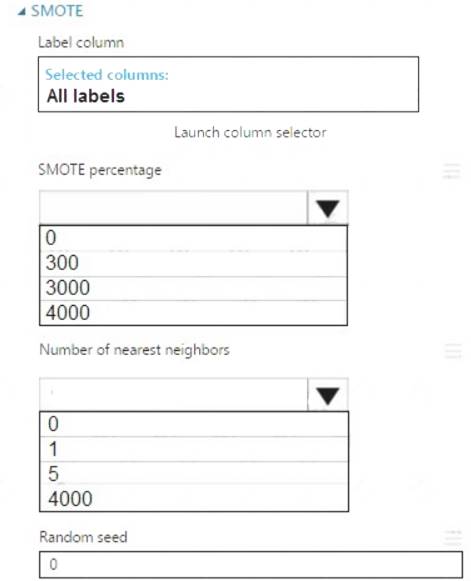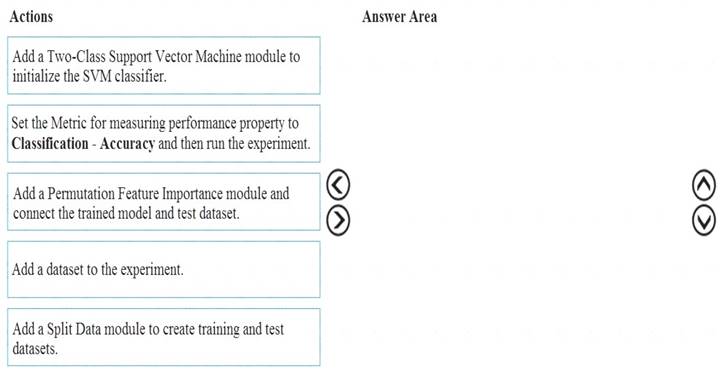- (Exam Topic 3)
You create an experiment in Azure Machine Learning Studio. You add a training dataset that contains 10,000 rows. The first 9,000 rows represent class 0 (90 percent).
The remaining 1,000 rows represent class 1 (10 percent).
The training set is imbalances between two classes. You must increase the number of training examples for class 1 to 4,000 by using 5 data rows. You add the Synthetic Minority Oversampling Technique (SMOTE) module to the experiment.
You need to configure the module.
Which values should you use? To answer, select the appropriate options in the dialog box in the answer area. NOTE: Each correct selection is worth one point.
Solution:
Box 1: 300
You type 300 (%), the module triples the percentage of minority cases (3000) compared to the original dataset (1000).
Box 2: 5
We should use 5 data rows.
Use the Number of nearest neighbors option to determine the size of the feature space that the SMOTE algorithm uses when in building new cases. A nearest neighbor is a row of data (a case) that is very similar to some target case. The distance between any two cases is measured by combining the weighted vectors of all features.
By increasing the number of nearest neighbors, you get features from more cases.
By keeping the number of nearest neighbors low, you use features that are more like those in the original sample.
References:
https://docs.microsoft.com/en-us/azure/machine-learning/studio-module-reference/smote
Does this meet the goal?
Correct Answer:
A
- (Exam Topic 2)
You need to select a feature extraction method. Which method should you use?
Correct Answer:
A
Spearman's rank correlation coefficient assesses how well the relationship between two variables can be described using a monotonic function.
Note: Both Spearman's and Kendall's can be formulated as special cases of a more general correlation coefficient, and they are both appropriate in this scenario.
Scenario: The MedianValue and AvgRoomsInHouse columns both hold data in numeric format. You need to select a feature selection algorithm to analyze the relationship between the two columns in more detail. References:
https://docs.microsoft.com/en-us/azure/machine-learning/studio-module-reference/feature-selection-modules
- (Exam Topic 3)
You create a deep learning model for image recognition on Azure Machine Learning service using GPU-based training.
You must deploy the model to a context that allows for real-time GPU-based inferencing. You need to configure compute resources for model inferencing.
Which compute type should you use?
Correct Answer:
B
You can use Azure Machine Learning to deploy a GPU-enabled model as a web service. Deploying a model on Azure Kubernetes Service (AKS) is one option. The AKS cluster provides a GPU resource that is used by the model for inference.
Inference, or model scoring, is the phase where the deployed model is used to make predictions. Using GPUs instead of CPUs offers performance advantages on highly parallelizable computation.
Reference:
https://docs.microsoft.com/en-us/azure/machine-learning/how-to-deploy-inferencing-gpus
- (Exam Topic 3)
You have a dataset that contains over 150 features. You use the dataset to train a Support Vector Machine (SVM) binary classifier.
You need to use the Permutation Feature Importance module in Azure Machine Learning Studio to compute a set of feature importance scores for the dataset.
In which order should you perform the actions? To answer, move all actions from the list of actions to the answer area and arrange them in the correct order.
Solution:
Step 1: Add a Two-Class Support Vector Machine module to initialize the SVM classifier.
Step 2: Add a dataset to the experiment
Step 3: Add a Split Data module to create training and test dataset.
To generate a set of feature scores requires that you have an already trained model, as well as a test dataset. Step 4: Add a Permutation Feature Importance module and connect to the trained model and test dataset. Step 5: Set the Metric for measuring performance property to Classification - Accuracy and then run the
experiment.
Reference:
https://docs.microsoft.com/en-us/azure/machine-learning/studio-module-reference/two-class-support-vector-mac https://docs.microsoft.com/en-us/azure/machine-learning/studio-module-reference/permutation-feature-importan
Does this meet the goal?
Correct Answer:
A
- (Exam Topic 3)
You plan to provision an Azure Machine Learning Basic edition workspace for a data science project. You need to identify the tasks you will be able to perform in the workspace.
Which three tasks will you be able to perform? Each correct answer presents a complete solution.
NOTE: Each correct selection is worth one point. D
Correct Answer:
ABD
Reference:
https://azure.microsoft.com/en-us/pricing/details/machine-learning/

